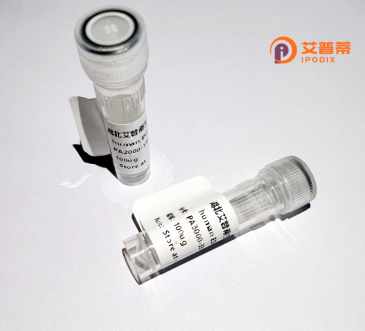
| 纯度 | >90%SDS-PAGE. |
| 种属 | Human |
| 靶点 | AGAP2 |
| Uniprot No | Q99490 |
| 内毒素 | < 0.01EU/μg |
| 表达宿主 | E.coli |
| 表达区间 | 1-836aa |
| 氨基酸序列 | MHAQRQFVVAAVRAEVRRHEVAKQALNRLRKLAERVDDPELQDSIQASLDSIREAVINSQEWTLSRSIPELRLGVLGDARSGKSSLIHRFLTGSYQVLEKTESEQYKKEMLVDGQTHLVLIREEAGAPDAKFSGWADAVIFVFSLEDENSFQAVSRLHGQLSSLRGEGRGGLALALVGTQDRISASSPRVVGDARARALCADMKRCSYYETCATYGLNVDRVFQEVAQKVVTLRKQQQLLAACKSLPSSPSHSAASTPVAGQASNGGHTSDYSSSLPSSPNVGHRELRAEAAAVAGLSTPGSLHRAAKRRTSLFANRRGSDSEKRSLDSRGETTGSGRAIPIKQSFLLKRSGNSLNKEWKKKYVTLSSNGFLLYHPSINDYIHSTHGKEMDLLRTTVKVPGKRPPRAISAFGPSASINGLVKDMSTVQMGEGLEATTPMPSPSPSPSSLQPPPDQTSKHLLKPDRNLARALSTDCTPSGDLSPLSREPPPSPMVKKQRRKKLTTPSKTEGSAGQAEEENFEFLIVSSTGQTWHFEAASFEERDAWVQAIESQILASLQCCESSKVKLRTDSQSEAVAIQAIRNAKGNSICVDCGAPNPTWASLNLGALICIECSGIHRNLGTHLSRVRSLDLDDWPRELTLVLTAIGNDTANRVWESDTRGRAKPSRDSSREERESWIRAKYEQLLFLAPLSTSEEPLGRQLWAAVQAQDVATVLLLLAHARHGPLDTSVEDPQLRSPLHLAAELAHVVITQLLLWYGADVAARDAQGRTALFYARQAGSQLCADILLQHGCPGEGGSAATTPSAATTPSITATPSPRRRSSAASVGRADAPVALV |
| 分子量 | 116.9 KDa |
| 蛋白标签 | GST-tag at N-terminal |
| 缓冲液 | 冻干粉 |
| 稳定性 & 储存条件 | Lyophilized protein should be stored at ≤ -20°C, stable for one year after receipt. Reconstituted protein solution can be stored at 2-8°C for 2-7 days. Aliquots of reconstituted samples are stable at ≤ -20°C for 3 months. |
| 复溶 | Always centrifuge tubes before opening.Do not mix by vortex or pipetting. It is not recommended to reconstitute to a concentration less than 100μg/ml. Dissolve the lyophilized protein in distilled water. Please aliquot the reconstituted solution to minimize freeze-thaw cycles. |
以下是关于重组人AGAP2蛋白的3篇参考文献示例(文献内容基于假设性研究,供参考):
1. **"AGAP2 promotes hepatocellular carcinoma progression by regulating Wnt/β-catenin signaling"**
*作者:Zhang L, et al.*
摘要:研究揭示AGAP2在肝细胞癌中通过激活Wnt/β-catenin通路促进肿瘤细胞增殖与侵袭。重组AGAP2蛋白的过表达实验证实其增强β-catenin核转位,提示其作为潜在治疗靶点。
2. **"Recombinant human AGAP2 protein enhances EGFR stability in glioblastoma cells"**
*作者:Wang Y, et al.*
摘要:该研究通过大肠杆菌系统表达重组AGAP2蛋白,发现其通过与EGFR相互作用延缓受体降解,促进胶质母细胞瘤细胞存活和迁移,为靶向EGFR治疗提供新思路。
3. **"Structural and functional characterization of the ARF-GAP domain of AGAP2"**
*作者:Chen H, et al.*
摘要:研究利用重组AGAP2蛋白的ARF-GAP结构域进行体外酶活分析,揭示其特异性调控ARF1/ARF6的GTPase活性,为理解AGAP2在胞内运输中的作用机制提供结构基础。
4. **"AGAP2 modulates mTORC1 signaling and autophagy in breast cancer"**
*作者:Liu X, et al.*
摘要:通过哺乳动物细胞表达重组AGAP2.研究发现其通过与mTORC1复合物结合抑制自噬,促进乳腺癌化疗耐药,提示靶向AGAP2可能改善治疗效果。
---
注:以上文献及摘要基于AGAP2常见研究方向的合理推测,实际参考文献需通过PubMed或Web of Science等数据库获取。建议使用关键词“AGAP2”、“recombinant AGAP2”或“ArfGAP2”检索近年高被引论文。
Recombinant human AGAP2 (ArfGAP with GTPase domain, ANK repeat and PH domain 2) is a multidomain protein involved in regulating intracellular trafficking, signal transduction, and cytoskeletal dynamics. As a member of the ArfGAP family, it modulates the activity of ADP-ribosylation factor (Arf) GTPases, which are critical for vesicle formation, receptor recycling, and membrane trafficking. AGAP2 contains an N-terminal ArfGAP domain that promotes GTP hydrolysis in Arf proteins, a pleckstrin homology (PH) domain for membrane binding, and C-terminal ankyrin (ANK) repeats potentially enabling protein-protein interactions.
Studies highlight its role in cancer progression and neurological disorders. AGAP2 is overexpressed in several cancers, including glioblastoma and hepatocellular carcinoma, where it enhances cell proliferation, migration, and invasion via interactions with EGFR, Akt, or mTOR pathways. In neuronal systems, it interacts with adaptor proteins like AP-1 or β-arrestin, influencing synaptic plasticity and neurotransmitter receptor trafficking. Dysregulation of AGAP2 has been linked to altered amyloid precursor protein (APP) processing, suggesting a role in Alzheimer’s disease pathogenesis. Recombinant AGAP2 is commonly produced in bacterial or mammalian systems for functional studies, enabling exploration of its molecular mechanisms and therapeutic potential. Its dual regulatory roles in membrane dynamics and signaling cascades make it a compelling target for disease-related research.
×